A young dicot seedling (e.g., soyabean) is laid horizontally on a surface and is subjected to gravity stimulus. The shoot bends in upward direction and the root bends in downwards direction. Which out of the following is the possible reason for this movement ?
a) Redistribution of auxins throughout the seedlings is responsible for the stimulatory unequal growth in shoots and roots.
b) Redistribution of cytokinins throughout the seddling is respondible for the stimulatory unequal growth in roots and shoots.
c) Redistribution of auxins in roots and cytokinins in shoots is responsible for stimulatory unequal growth.
d) Redistribution of auxins in shoots and cytokininis in roots is responsible for stimulatory unequal growth.
The correct Answer is:a
To answer the question regarding the bending of a young dicot seedling (like soybean) when laid horizontally and subjected to gravity, we can follow these steps:
1. Understanding the Situation:
- A young dicot seedling is placed horizontally. The shoot bends upwards while the root bends downwards.
- This indicates a response to gravity, which is known as gravitropism.
Hint: Consider how plants respond to different environmental stimuli.
2. Identifying the Hormone Involved:
- The primary hormone responsible for the growth direction in plants is auxin. Auxin plays a crucial role in regulating plant growth and responses to stimuli.
Hint: Think about which plant hormones are known to influence growth direction.
3. Mechanism of Action of Auxin:
- Auxin is synthesized at the tip of the shoot and is unevenly distributed in response to gravity.
- When the seedling is horizontal, auxin accumulates more on the lower side of the shoot and root.
Hint: Reflect on how the distribution of hormones can affect growth rates in different parts of the plant.
4. Effect of Auxin on Growth:
- In the shoot, higher concentrations of auxin promote cell elongation, causing the shoot to bend upwards (phototropism).
- In the root, auxin inhibits growth on the side with higher concentration, causing the root to bend downwards (gravitropism).
Hint: Consider how different concentrations of the same hormone can have opposite effects in different plant parts.
5. Conclusion:
- The bending of the shoot upwards and the root downwards is due to the unequal distribution of auxin, leading to differential growth rates.
- Therefore, the correct answer to the question is that the redistribution of auxins throughout the seedling is responsible for the stimulatory unequal growth in shoots and roots.
Hint: Summarize the role of auxin in both the shoot and root to clarify its impact on growth direction.
Final Answer:
The possible reason for the movement of the young dicot seedling is the redistribution of auxins throughout the seedling, which is responsible for the stimulatory unequal growth in shoots and roots.
- A young dicot seedling is placed horizontally. The shoot bends upwards while the root bends downwards.
- This indicates a response to gravity, which is known as gravitropism.
- The primary hormone responsible for the growth direction in plants is auxin. Auxin plays a crucial role in regulating plant growth and responses to stimuli.
- Auxin is synthesized at the tip of the shoot and is unevenly distributed in response to gravity.
- When the seedling is horizontal, auxin accumulates more on the lower side of the shoot and root.
- In the shoot, higher concentrations of auxin promote cell elongation, causing the shoot to bend upwards (phototropism).
- In the root, auxin inhibits growth on the side with higher concentration, causing the root to bend downwards (gravitropism).
- The bending of the shoot upwards and the root downwards is due to the unequal distribution of auxin, leading to differential growth rates.
- Therefore, the correct answer to the question is that the redistribution of auxins throughout the seedling is responsible for the stimulatory unequal growth in shoots and roots.
The possible reason for the movement of the young dicot seedling is the redistribution of auxins throughout the seedling, which is responsible for the stimulatory unequal growth in shoots and roots.
Topper's Solved these Questions
- BOOK - NCERT FINGERTPS ENGLISHCHAPTER - PLANT GROWTH AND DEVELOPMENTEXERCISE - Examplar problems12videos
PLANT GROWTH AND DEVELOPMENT
- BOOK - NCERT FINGERTPS ENGLISHCHAPTER - PLANT GROWTH AND DEVELOPMENTEXERCISE - Assertion & Reason15videos
PLANT GROWTH AND DEVELOPMENT
- BOOK - NCERT FINGERTPS ENGLISHCHAPTER - PLANT GROWTH AND DEVELOPMENTEXERCISE - Seed dormancy5videos
PLANT GROWTH AND DEVELOPMENT
- BOOK - NCERT FINGERTPS ENGLISHCHAPTER - PHOTOSYNTHESIS IN HIGHER PLANTSEXERCISE - Photosynthesis In Higher Plants136videos
PHOTOSYNTHESIS IN HIGHER PLANTS
- BOOK - NCERT FINGERTPS ENGLISHCHAPTER - PLANT KINGDOMEXERCISE - Plant Kingdom160videos
PLANT KINGDOM
Similar Questions

in the given figure a ring of mass m is kept on a horizontal surface while a body of equal mass m si attached through string, which is wounded on the ring. When the system is released the ring rolls without slipping. consider the following statement and choose the correct options.
(i). Acceleration of centre of mass of ring is 2g3
(ii). acceleration of hanging particle is 4g3
(iii). Frictional force (on the ring) acts in backward direction.
(iv) . Frictional force (on the ring) acts in backward direction.View SolutionA rectangular tank filled with some liquid is accelerated along a horizontal surface at 403ms−2. Inside the liquid, a laser pointer is fixed a the centre of the tank which shoots a thin laser beam in the vertically upward direction. If after refraction from the liquid surface, the laser beam moves along the surface of the liquid, then what is the refrctive index of the liquid ?
View SolutionThe force of interaction between the molecules of same substance is called cohesive force hile force of interaction between molecules of different substances is called adhesive force . Both the forces are attracive and have a range of about 10 A . If we consider a molecule . A well inside a liquid we find that it is equally attracted by the surrounding molecules in all the directions ( with a sphere of radius 10 Å ) and so it does not experience any resultant force . On or near the surface of a liquid , the molecules do not exist on the free side and so a molecule ( say B ) experiences a resultant force vertically downwards into the liquid . For this reason , the molecules of the surface have a tendency to go into the liquid . Thus , the surface tends to contract and gives rise to surface tension .
As surface molecules like B experience a net downward force of cohension and have tendency to go down , so in increasing the area of the surface more molecules are to be shifted to the surface from inside . Thus , more mechnical work will have to be done against the net downward force of cohension . This work is stored by the molecules in the surfaces as potential energy called free surface energy .
Furthermore , molcules like P , in contact with the liquid will stick to the solid surface , i.e will meet it if the force of adhesion A is greater than net force of cohension C . The liquid will not the solid surface if C>A
Also , molecules like Q at the surface in contact with the solid will experience a net force of cohension CR . If adhesion A is greater then cohension CR , the resultant force will be F . As the liquid can't support tangential force , F must be perpendicular to the surface of the liquid . So , the menisus will be concave and the angle of contact will be acute (>90∘) . However , if adhesion is lesser than cohension , the resultant force F will be directed into the liquid and so the menisus ( which is perpendicular to F as liquid support tangential force ) will be convex and the angle of contact will be obtuse (>90∘)

A liquid particle B , which is present in the vicinity particle A can exert a force on A if the distance of B from A is
View SolutionThe force of interaction between the molecules of same substance is called cohesive force hile force of interaction between molecules of different substances is called adhesive force . Both the forces are attracive and have a range of about 10 A . If we consider a molecule . A well inside a liquid we find that it is equally attracted by the surrounding molecules in all the dirctions ( with a sphere of radius 10 Å ) and so it does not experience any resultant force . On or near the surface of a liquid , the molecules do not exist on the free side and so a molecule ( say B ) experiences a resultant force vertically downwards into the liquid . For this reason , the molecules of the surface have a tendency to go into the liquid . Thus , the surface tends to contract and gives rise to surface tension .
As surface molecules like B experience a net downward force of cohension and have tendency to go down , so in increasing the area of the surface more molecules are to be shifted to the surface from inside . Thus , more mechnical work will have to be done against the net downward force of cohension . This work is stored by the molecules in the surfaces as potential energy called free surface energy .
Furthermore , molcules like P , in contact with the liquid will stick to the solid surface , i.e will meet it if the force of adhesion A is greater than net force of cohension C . The liquid will not the solid surface if C>A
Also , molecules like Q at the surface in contact with the solid will experience a net force of cohension CR . If adhesion A is greater then cohension CR , the resultant force will be F . As the liquid can't support tangential force , F must be perpendicular to the surface of the liquid . So , the menisus will be concave and the angle of contact will be acute (>90∘) . However , if adhesion is lesser than cohension , the resultant force F will be directed into the liquid and so the menisus ( which is perpendicular to F as liquid support tangential force ) will be convex and the angle of contact will be obtuse (>90∘)

The free suface energy , stored in the surface is because of work doneView SolutionFluids at rest exert a normal force to the walls of the container or to the sruface of the body immersed in the fluid. The pressure exerted by this force at a point inside the liqid is the sum of atmospheric pressure and a factor which depends on the density of the liquid, the acceleration due to gravity and the height of the liquid, above that point. The upthrust acting on a body immersed in a stationary liquid is the net force acting on the body in the upward direction. A number of phenomenon of liquids in motion can be explain by Bernoulli's theorem which relates the pressure, flow speed and height for flow of an ideal incompressible fluid.
A container of large uniform corss sectional area. A resting on a horizontal surface holds two immiscible, non viscous and incompressile liquids of densities d and 2d, each of height H/2 as shown in the figure. The lower density liquid is open to the atmosphere having pressure P0.
Situation II:
A cyliner is removed and the original arrangement is restoreed.A tiny hole of area s(s<<A) is punched on the veritical sideof the containier at a height h(h<H/2)
The horizontal distance x travelled by the liquid isView SolutionFluids at rest exert a normal force to the walls of the container or to the sruface of the body immersed in the fluid. The pressure exerted by this force at a point inside the liqid is the sum of atmospheric pressure and a factor which depends on the density of the liquid, the acceleration due to gravity and the height of the liquid, above that point. The upthrust acting on a body immersed in a stationary liquid is the net force acting on the body in the upward direction. A number of phenomenon of liquids in motion can be explain by Bernoulli's theorem which relates the pressure, flow speed and height for flow of an ideal incompressible fluid.
A container of large uniform corss sectional area. A resting on a horizontal surface holds two immiscible, non viscous and incompressile liquids of densities d and 2d, each of height H/2 as shown in the figure. The lower density liquid is open to the atmosphere having pressure P0.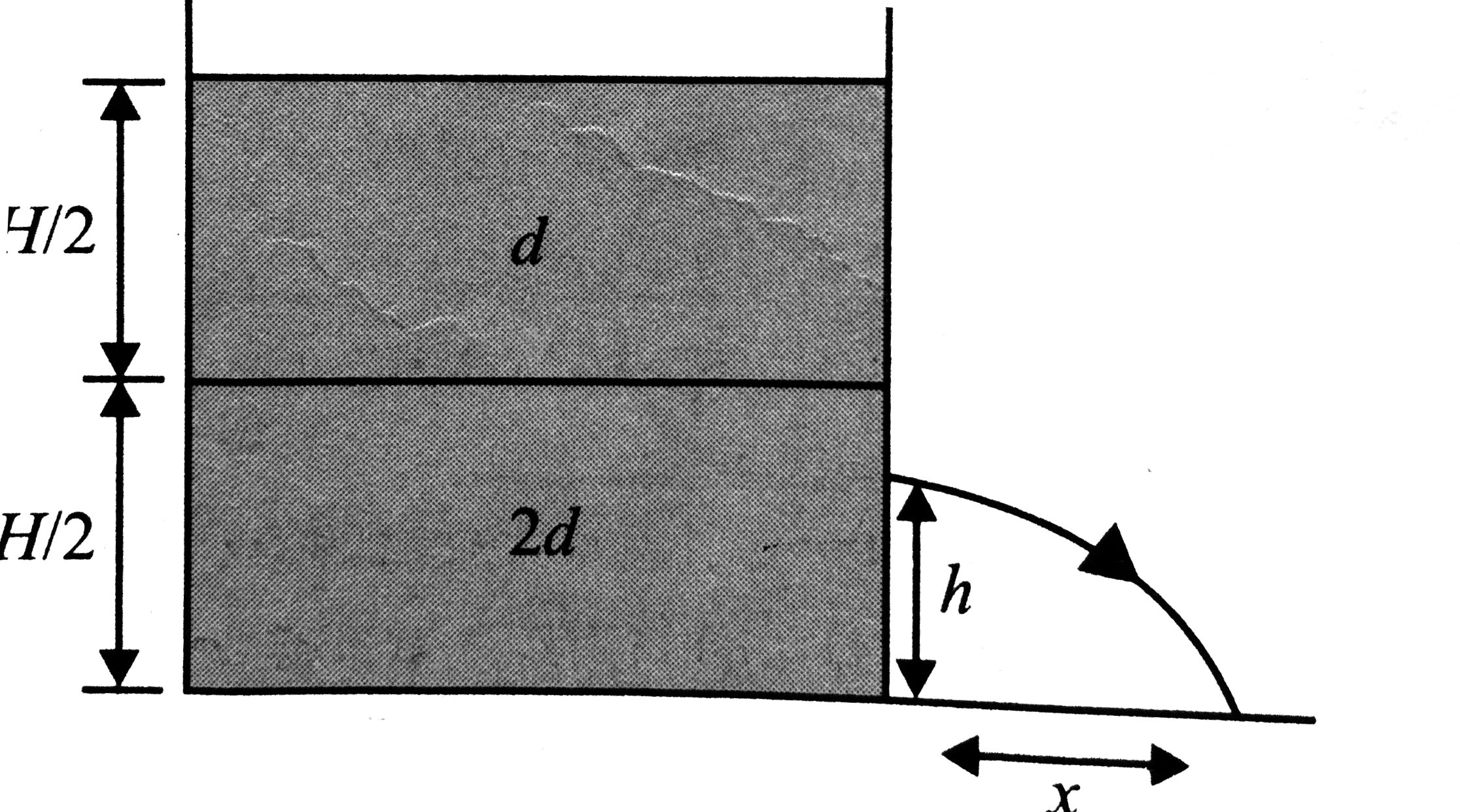
Situation II:
A cyliner is removed and the original arrangement is restoreed.A tiny hole of area s(s<<A) is punched on the veritical side of the containier at a height h(h<H/2)
The height hm at which the hole should be punched so that the liquid travels the maximum distance isView SolutionFluids at rest exert a normal force to the walls of the container or to the sruface of the ody immersed in the fluid. The pressure exerted by this force at a point inside the liqid is the sum of atmospheric pressure and a factor which depends on the density of the liquid, the acceleration due to gravity and the height of the liquid, above that point. The upthrust acting on a body immersed in a stationary liquid is the net force acting on the body in the upward direction. A number of phenomenon of liquids in motion can be explain by Bernoulli's theorem which relates the pressure, flow speed and height for flow of an ideal incompressible fluid.
A container of large uniform corss sectional area. A resting on a horizontal surface holds two immiscible, non viscous and incompressile liquids of densities d and 2d, each of height H/2 as shown in the figure. The lower density liquid is open to the atmosphere having pressure P0.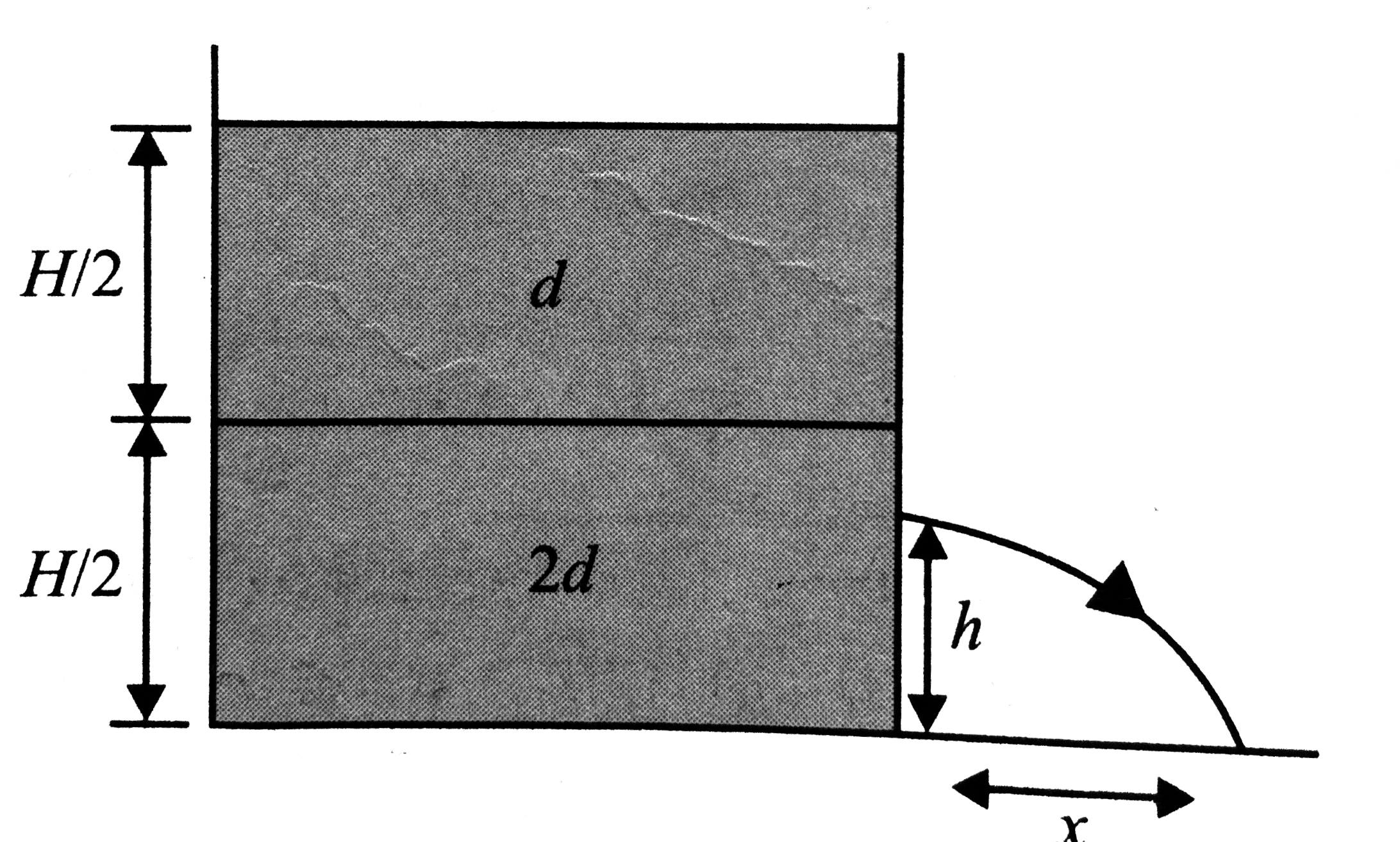
Situation II:
A cyliner is removed and the original arrangement is restoreed.A tiny hole of area s(s<<A) is punched on the veritical side of the container at a height h(h<H/2)
The maximum distance travelled xm isView SolutionFluids at rest exert a normal force to the walls of the container or to the sruface of the Body immersed in the fluid. The pressure exerted by this force at a point inside the liqid is the sum of atmospheric pressure and a factor which depends on the density of the liquid, the acceleration due to gravity and the height of the liquid, above that point. The upthrust acting on a body immersed in a stationary liquid is the net force acting on the body in the upward direction. A number of phenomenon of liquids in motion can be explain by Bernoulli's theorem which relates the pressure, flow speed and height for flow of an ideal incompressible fluid.
A container of large uniform corss sectional area. A resting on a horizontal surface holds two immiscible, non viscous and incompressile liquids of densities d and 2d, each of height H/2 as shown in the figure. The lower density liquid is open to the atmosphere having pressure P0.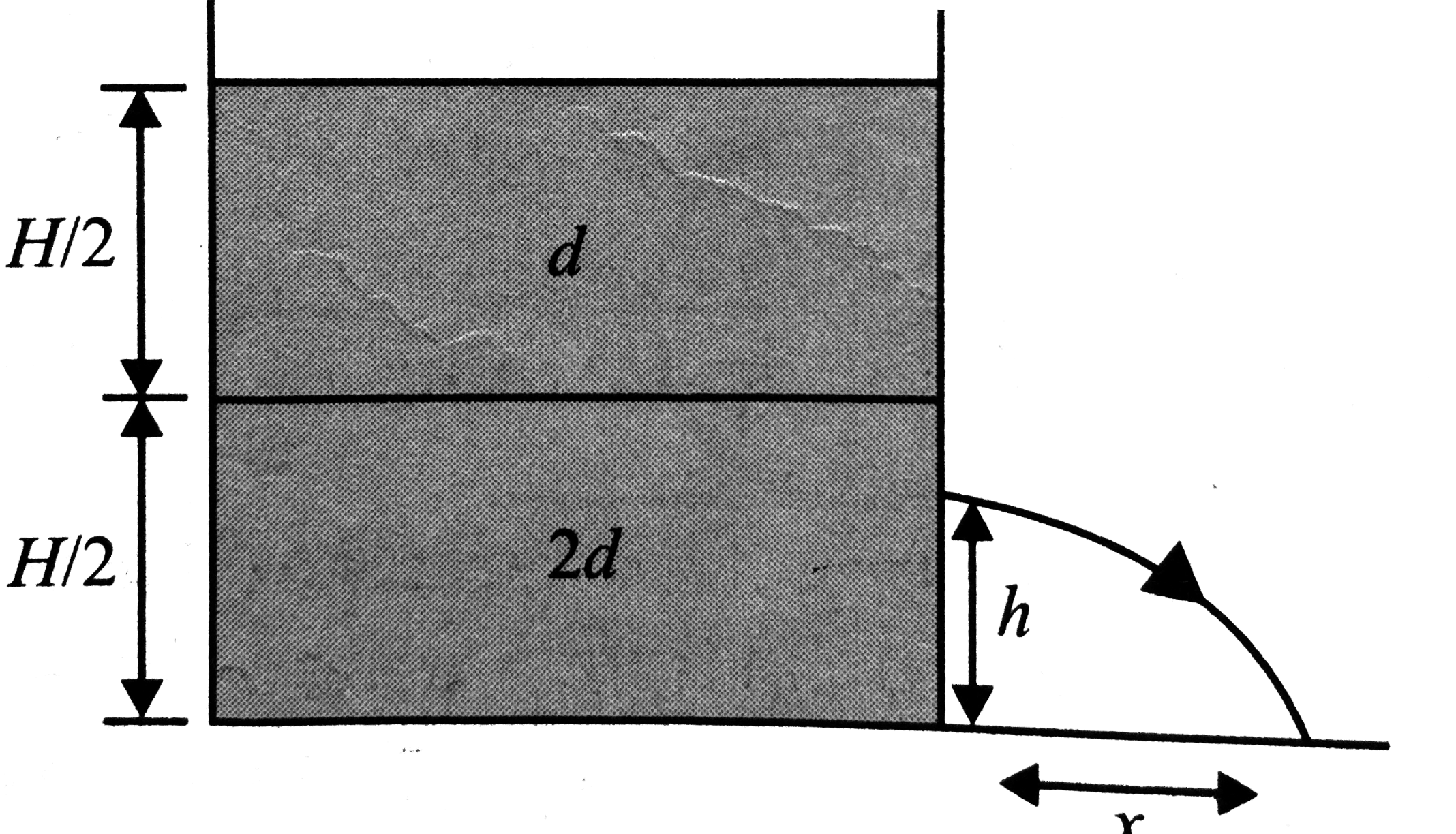
Situation I:
A homogeneous solid cylinder of length L(L<H/2). cross sectional area A/5 is immersed such that it floats with its axis vertical at liquid -liquid interface with lenght L/4 in the denser liquid.
The density of the solid isView SolutionFluids at rest exert a normal force to the walls of the container or to the sruface of the body immersed in the fluid. The pressure exerted by this force at a point inside the liqid is the sum of atmospheric pressure and a factor which depends on the density of the liquid, the acceleration due to gravity and the height of the liquid, above that point. The upthrust acting on a body immersed in a stationary liquid is the net force acting on the body in the upward direction. A number of phenomenon of liquids in motion can be explain by Bernoulli's theorem which relates the pressure, flow speed and height for flow of an ideal incompressible fluid.
A container of large uniform corss sectional area. A resting on a horizontal surface holds two immiscible, non viscous and incompressile liquids of densities d and 2d, each of height H/2 as shown in the figure. The lower density liquid is open to the atmosphere having pressure P0.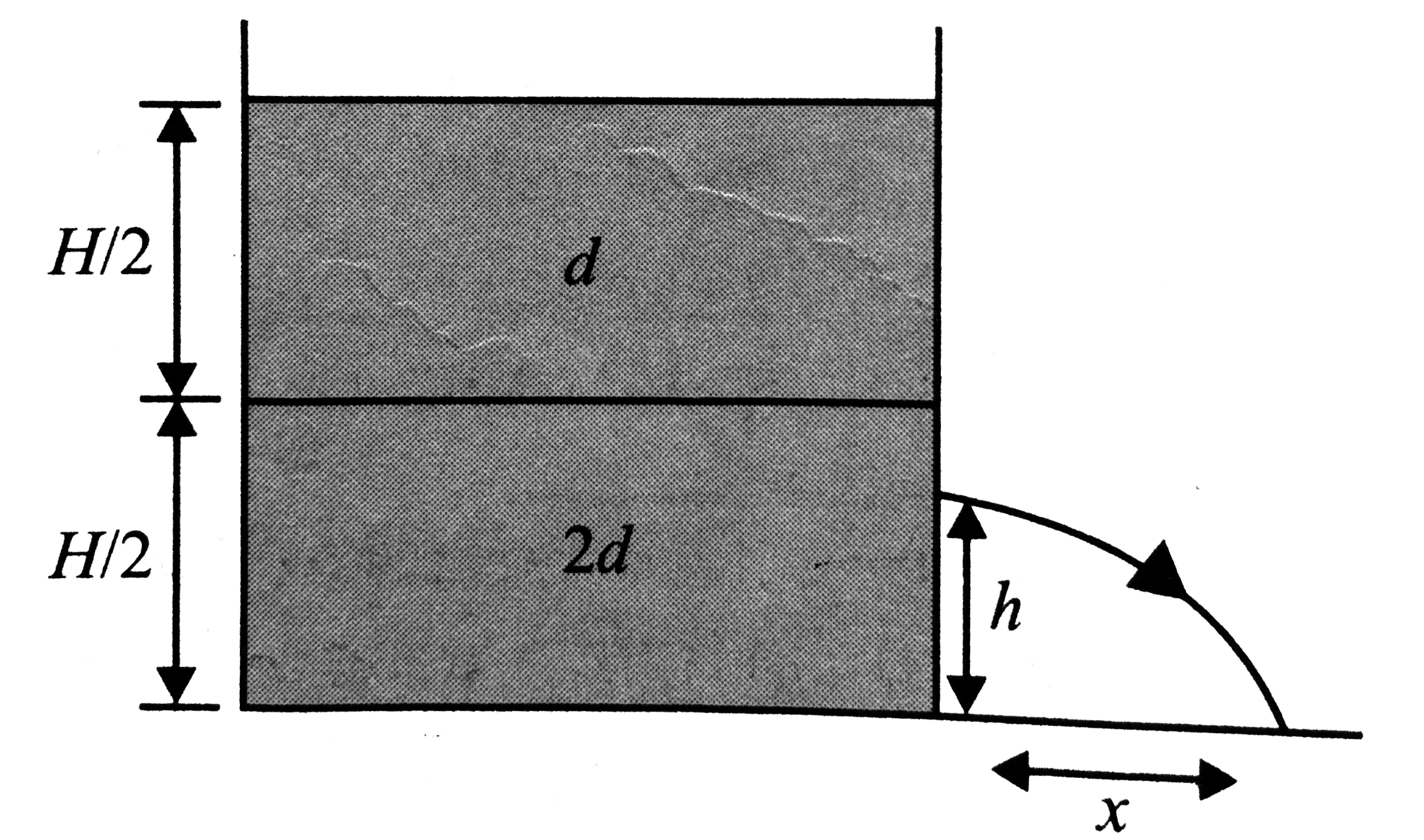
Situation I:
A homogeneous solid cylinder of length L(L<H/2). cross sectional area A/5 is immersed such that it floats with its axis vertical at liquid -liquid interface with lenght L/4 in the denser liquid.
The total pressure at the bottom of the container isView SolutionFluids at rest exert a normal force to the walls of the container or to the sruface of the body immersed in the fluid. The pressure exerted by this force at a point inside the liqid is the sum of atmospheric pressure and a factor which depends on the density of the liquid, the acceleration due to gravity and the height of the liquid, above that point. The upthrust acting on a body immersed in a stationary liquid is the net force acting on the body in the upward direction. A number of phenomenon of liquids in motion can be explain by Bernoulli's theorem which relates the pressure, flow speed and height for flow of an ideal incompressible fluid.
A container of large uniform cross sectional area. A resting on a horizontal surface holds two immiscible, non viscous and incompressile liquids of densities d and 2d, each of height H/2 as shown in the figure. The lower density liquid is open to the atmosphere having pressure P0.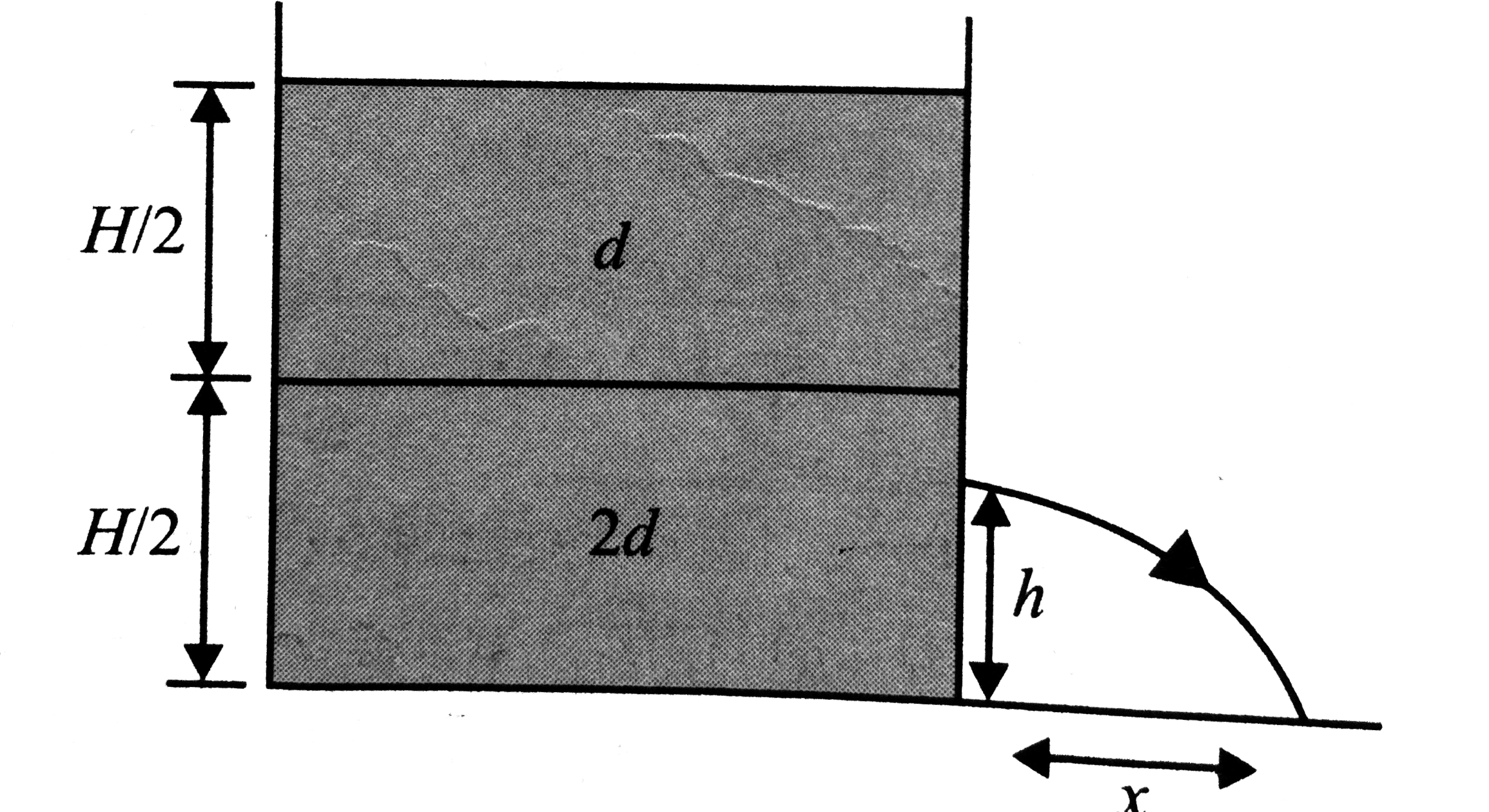
Situation II:
A cyliner is removed and the original arrangement is restored.A tiny hole of area s(s<<A) is punched on the veritical sideof the containier at a height h(h<H/2)
The initial speed of efflux of the liquid at the hole isView Solution

